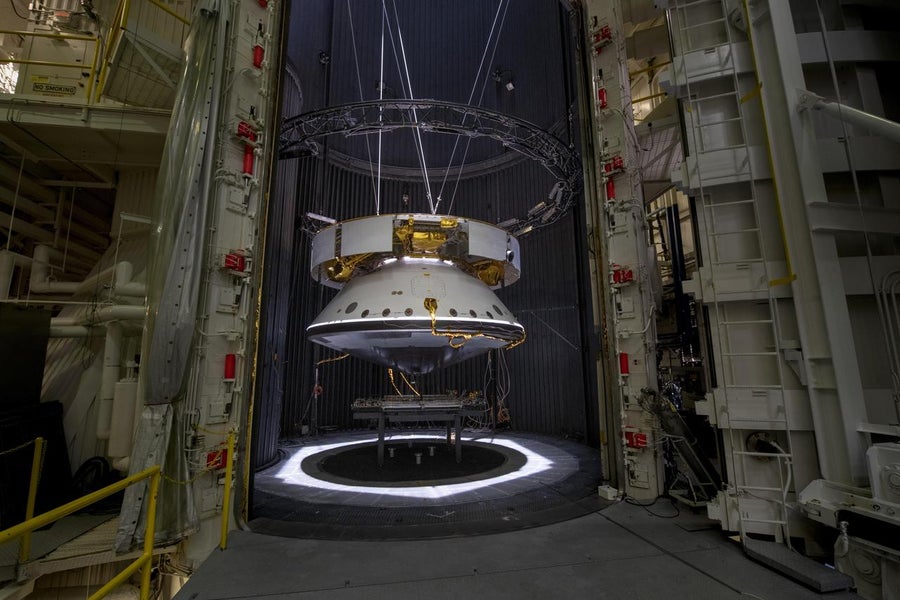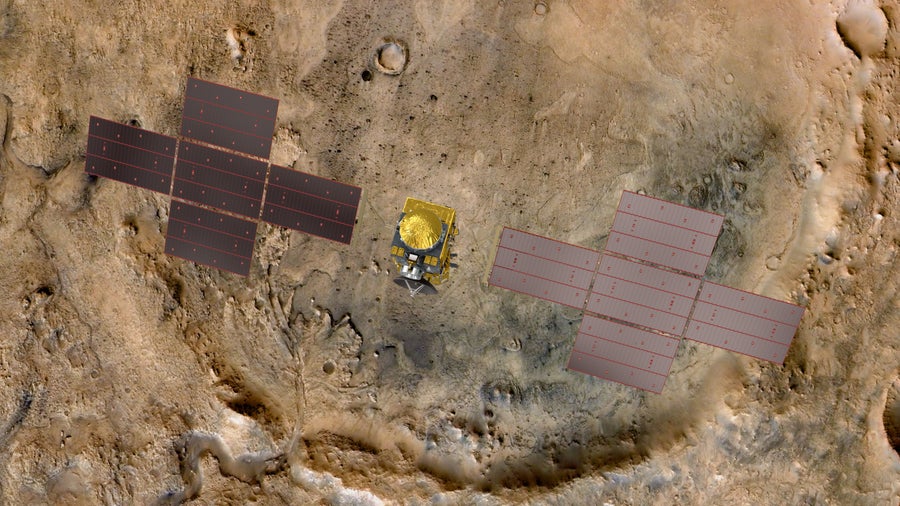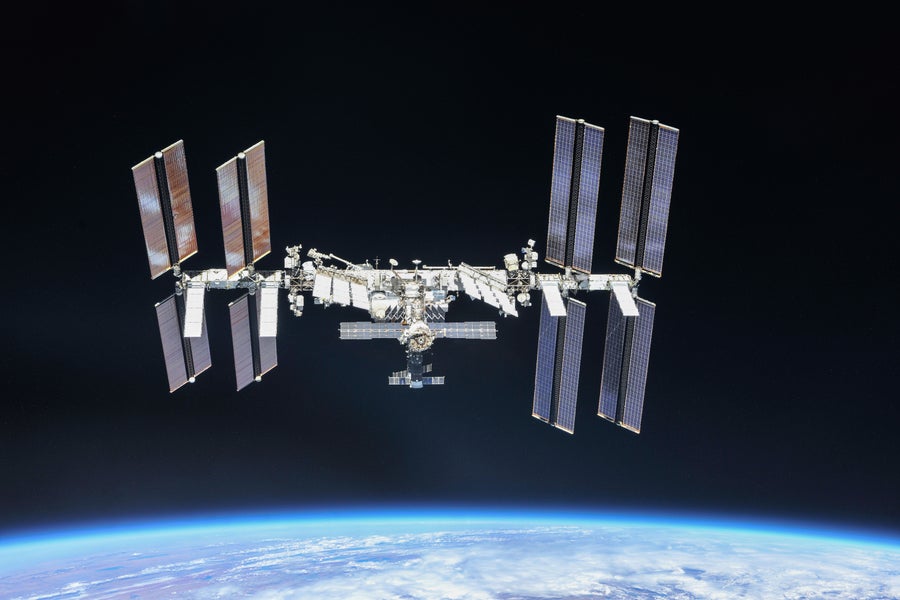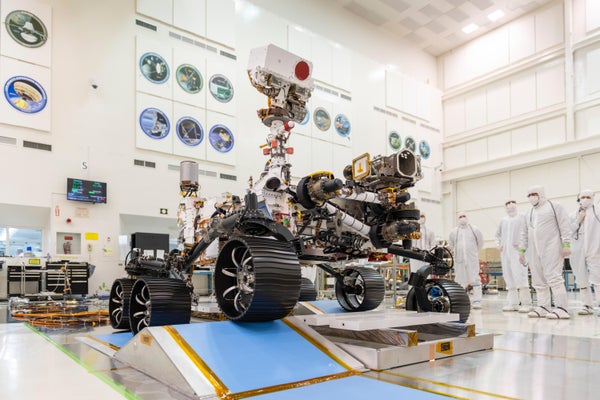In 2031 a cannonball shot from Mars should fall to Earth somewhere in the deserts of the western U.S., allowing scientists to get their hands on what some would consider the most precious materials in human history: pristine geologic samples taken from the surface of another planet.
Decades in the making, this moment would represent the zenith of the robotic Mars Sample Return (MSR) mission, an international endeavor involving NASA, the European Space Agency (ESA) and a consortium of industry partners. But its realization is far from a foregone conclusion.
Aside from one component—NASA’s Mars 2020 rover, set to launch as early as July—the multistage mission remains mostly conceptual, despite its estimated $7-billion price tag. And more than just a myriad of technical obstacles and never before seen acts of spacefaring derring-do stand in the way of success. There is no guarantee that two space agencies—each funded by, and emblematic of, very different political systems—can work perfectly in tandem to meet the milestones in the mission’s breathtakingly tight 11-year time line. The difficulties even extend beyond what would seem to be the greatest challenge: actually returning the hard-won samples to Earth. Mission planners are still debating how, exactly, to safeguard the rocks from Mars against Earthly contamination, as well as any possible outbreak, no matter how unlikely, of an alien organism.
On supporting science journalism
If you're enjoying this article, consider supporting our award-winning journalism by subscribing. By purchasing a subscription you are helping to ensure the future of impactful stories about the discoveries and ideas shaping our world today.
Whether considered in terms of complexity or audacity, MSR will serve as a touchstone for all future major interplanetary robotic missions. There is every chance it could fail, becoming little more than a multi-billion-dollar monument to interagency malfunction. But if MSR’s planners manage to pull it off, the mission will epitomize the merits of international frameworks for off-world operations, delivering untold scientific treasures and, just maybe, triggering a seismic shift in society’s perceptions of space exploration.
“It would be a human achievement, not just a NASA or ESA achievement,” says Casey Dreier, senior space policy adviser at the Planetary Society.
The Great Interplanetary Boomerang
Getting unaltered samples from Mars back to Earth has been a key goal for several successive generations of planetary scientists. Researchers have already found important clues to the Red Planet’s remote past within a small number of meteorites chipped off of Mars and hurled to Earth by ancient giant impacts. But those space rocks are exceedingly rare—and so physically transformed by their improbable journey that they are of limited use in answering scientists’ most pressing questions.
Studying pristine Mars rocks on Earth using any methods or instruments we desire, though, could unspool a more richly detailed history of our neighboring world, revealing the evolution of its volcanism, hydrology, climate, magnetism and, perhaps, biology. Not even an entire fleet of robotic missions could provide all of those data, says María-Paz Zorzano, a senior scientist at Spain’s Center of Astrobiology. And besides, she adds, “if you ever want to send humans to Mars, you first have to demonstrate that you can bring something safe back.”
Although subject to change, NASA and ESA have sketched out a plan to pull off this interplanetary grab-and-go mission. The nuclear-powered Mars 2020 rover is presently in a clean room in California in preparation for its launch this summer. It is expected to land in Jezero Crater, a site of potential past habitability, just north of the Martian equator, in February 2021. If life ever existed on Mars, there is a nonnegligible chance it could have flourished (and perhaps even fossilized) in the ancient crater lake and associated river system in and around Jezero. While conducting various experiments there, the Mars 2020 rover could extract up to 43 pen-sized rock samples using a drill. The samples would then be sealed away in tubes. Some of them would be stored on the rover, and others would instead be cached in some convenient nearby location on the planet’s surface.

View from NASA’s Mars Reconnaissance Orbiter, looking down on an ancient river delta nestled within Jezero Crater, the landing site for the Mars 2020 rover. Credit: NASA, JPL-Caltech, MSSS and JHU-APL
As it curates its rock collection, the rover’s communiqués to Earth will have to rely on somewhat antiquated orbital architecture. Mars Odyssey (launched in 2001) will run out of propellant by 2025, and the batteries of the Mars Reconnaissance Orbiter (launched in 2005) could fizzle out around the same time, potentially preventing either spacecraft from serving as a communications relay. Mars Atmosphere and Volatile Evolution, or MAVEN (launched in 2013), is still going strong, but the ExoMars Trace Gas Orbiter (launched in 2016) will likely be the main data conduit for the Mars 2020 rover.
If this cobbled-together communications scheme were to fail, the rover’s adventure could be cut short or, worse yet, end before it began. That situation means “we have to strike while we have this infrastructure there,” Dreier says. Even if the Trace Gas Orbiter remains functional for many years to come, the Mars 2020 rover will have to share the orbiter’s bandwidth with, among devices, ESA’s Rosalind Franklin rover, which also arrives in 2021. This arrangement may lead to limitations in the amount of data that can be sent back home, says Sanjay Vijendran, ESA’s campaign lead for MSR.
Mars 2020 will launch, come hell or high water. But subsequent mission stages are yet to become a reality. The “sample return” train has left the station with the tracks ahead of it still being built.
In 2026, if all goes according to plan, two launches will take place: One rocket will carry ESA’s Earth Return Orbiter. Another will loft NASA’s Sample Return Lander mission, which will transport NASA’s Mars Ascent Vehicle and ESA’s Sample Fetch Rover to our rust-hued neighbor. The orbiter will arrive at Mars first, in 2028, in order to monitor the later-arriving lander’s entry, descent and landing.
Traversing the landscape using a preplanned path uploaded by MSR scientists, the Sample Fetch Rover will seek to grab all of Mars 2020’s cached sample tubes using its robotic arm before delivering them back to the lander. Its navigation and sample pickup will be handled autonomously, saving time, compared with the more step-by-step, slowly-but-surely approach of using a remote pilot. But the device can signal back home to request human help if it encounters some particularly perilous terrain. If the initial Mars 2020 rover is still operational, it could also deliver its own samples to the Sample Return Lander, Vijendran says.
Various private companies are developing concept studies for both ESA’s Sample Fetch Rover and its Earth Return Orbiter. What concerns Adam Camilletti, engineering manager for the ESA rover at aerospace company Airbus, is sticking to the time line on treacherous terrain: the solar-powered vehicle—lacking a nuclear battery (partly for want of more funding)—can ill afford to get stuck anywhere for long. That restriction exists because the Sample Fetch Rover only has around 150 Martian days to deliver all those samples to the lander before the darker winter months—and seasonal spates of solar-power-scuttling dust storms—roll in. A second robotic arm on the awaiting lander will snatch the rover-delivered sample tubes, placing them into a soccer-ball-sized container, which will then be blasted into orbit by the Mars Ascent Vehicle.

Spacecraft that will take the Mars 2020 rover to the Red Planet, seen here suspended by cables at NASA’s Jet Propulsion Laboratory. Credit: NASA and JPL-Caltech
Most experts suspect that liftoff will be the mission’s most challenging event. Mars has only a slim fraction of our own planet’s gravity and atmosphere, allowing an easier ride to space, compared with anything launched from Earth. But the ascent vehicle will have to perform flawlessly—and, save for the initial launch command, entirely autonomously, without any human intervention to save it, should a problem arise.
And despite its benefits for space launches, the Martian environment has substantial drawbacks, too. Leaving the rocket for several months in the bitter cold while the fetch rover does its business is a big risk, says Jorge Vago, ExoMars project scientist at ESA. On Earth, solid rocket fuel does not always burn properly after exposure to cold temperatures. Conditions on Mars are far colder, and the ascent vehicle’s exposure time will be far longer than, say, sounding rockets launched into Earth’s aurora borealis from inside the Arctic Circle. Liquid fuels could be more reliable, but they would require a complex valve system that would introduce additional potential points of failure.
Anita Sengupta, a rocket scientist and astronautic engineer at the University of Southern California, was responsible for developing the supersonic parachute system that allowed NASA’s Curiosity rover to safely touch down on Mars. Landing robots on another world is hardly worry-free, she says. Space agencies have had plenty of practice in this department and multiple successes to build on, but launching a rocket off another planet remotely, with no chance to fix a faulty valve or scrub a launch, is a whole new ball game. “No one has ever done anything like this in the history of time,” Sengupta says.
The launch will be “one of those nail-biting moments,” says Michael Meyer, lead scientist of NASA’s Mars Exploration Program. If it succeeds, it will release the sample container to float freely in Mars orbit. The Earth Return Orbiter will then use its onboard cameras to locate the sample container, ultimately rendezvousing with, capturing and stowing its quarry high above Mars—and beyond the reach of any helpful intervention from mission controllers on Earth. This crucial step will rely solely on the spacecraft’s ability to navigate and hunt down a tiny container in Mars orbit without the aid of an Earth-like GPS satellite network.

Artist’s impression of the European Space Agency’s Earth Return Orbiter, high above Mars. The spacecraft is one of several stages of the mission that is, for now, entirely conceptual. Credit: ESA and ATG Medialab
Utah, We Have a Problem
Before any Mars-bound spacecraft leaves Earth, it usually spends time baking in an oven, where it is carefully sterilized to reduce the chance that any microbial hitchhikers will contaminate the alien world. But scientists also worry about “backward contamination”—the notion that any Martian biota could contaminate Earth and put us or our biosphere in grave danger.
Astrobiologists assign astronomical odds against extant life being found in any of MSR’s rocks. “The likelihood of there being anything in that sample that is dangerous is approaching zero,” says Manish Patel, a planetary scientist at the Open University, based in England. “The problem is that we cannot say it is zero.”
There is essentially no chance that something that evolved on Mars would be able to infect humans and cause disease, says Jonathan Eisen, an evolutionary biologist at the University of California, Davis. More likely, he says, it could cause ecological problems on Earth if it found its way into environments where it could proliferate with reckless abandon.
Although perhaps improbable, such risks are taken very seriously. MSR’s treasure trove will have to be meticulously sealed, so humans will not come into direct contact with the Martian dust, rocks and soil. For that reason, when the Earth-return spacecraft captures the dust-covered sample container in Martian orbit, it will sequester that container inside a multilayered capsule. The action, Meyer says, will be like a glove catching a dusty baseball and then being packaged away with it several times over.
The orbiter should arrive above Earth with its precious, well-protected cargo in 2031. Eisen suggests that at this point, the samples should be initially studied in space, perhaps onboard the International Space Station or some other orbital facility. “If you’re up on the Space Station, and you do a bunch of tests, and you find out [something in the samples] is alive, it’s inexcusable to bring it to Earth,” he says.
This step does not currently feature in the mission’s working plan. Instead when the orbiter gets to Earth, the capsule is expected to reach terra firma via NASA’s Earth Entry Vehicle, which would make a hard landing, without the aid of parachutes, in a U.S. desert (tentatively in Utah) at speeds of around 90 miles per hour. “It’s fast, but it’s not crazy fast,” Vijendran says.
MSR’s masters are foregoing parachutes because the devices cannot be guaranteed to work, Vijendran says—something immortalized in 2004 by the solar-wind-particle-gathering Genesis mission, whose sample capsule broke open after an unintentional hard landing. In this case, it is simpler to build a rigid capsule that can withstand such a landing. “It just comes in, and, wham, it hits the ground,” Vago says. “That’s going to be an interesting one.”
Gerhard Kminek, ESA’s planetary protection officer, says that having multiple protective systems onboard the return vehicle reduces the odds that the samples would spill out into the desert. If the capsule does not crack open like an egg, its next stop would be a receiving facility where the samples would be placed in the world’s most impenetrable, biologically secure vault for their initial study.
This facility does not currently exist. A “planetary protection” review boardconvened by NASA last year noted the problem and recommended that work on the MSR-receiving facility be accelerated. Experts agree that we need at least a 10-year head start when it comes to building these spaces, Kminek says. And Martian samples are expected to rendezvous with Earth in 11 years. It seems the hourglass is rapidly running out of sand.
Some basic requirements are clear. The samples would be treated as if they were highly virulent, like smallpox, Patel says: they would likely be kept at the highest possible biosafety level, where workers must don hazmat suits within self-contained oxygen tanks. Multiple airlocks—as well as a lower-than-ambient air pressure inside the facility—would ensure air from within would not rush outside.
Several preexisting biocontainment spaces can fulfill these basics, including those at military bases designed to contain potential bioweapons, says Elliot Sefton-Nash, a study scientist for MSR at ESA. But they are likely still too contaminated to support careful astrobiological studies. Current facilities, for instance, typically do not care if outside air sneaks in. But in the case of analyzing extraterrestrial rocks, such transgressions could easily sully the samples, potentially leading to a false discovery of Martian life. One option, Sefton-Nash says, would be to install specialized cabinets in which the sample would be protected from us, and us from them, by multiple layers of inert gas. Investigators could then use remotely operated robotic micromanipulators to study them. Michelle Thompson, a returned-sample analysis expert at Purdue University, says we also need to consider specifically training early-career researchers who will be ready to work in these spaces in 2031.
A single U.S. facility ticking all of these boxes could cost around $500 million, Dreier says. And it is not yet clear if others will be built in Europe. Forget obtaining the samples: dealing with them is a mission unto itself, he adds.

Some experts suggest that the returning Martian samples should initially be studied in space, perhaps on the International Space Station, in order to reduce the risk of extraterrestrial microbes proliferating on Earth. Credit: Roscosmos and NASA
Show Me the Money
As it stands, MSR remains a concept. It still needs funding throughout its tenure, and right now, NASA and ESA are at very different stages of budgeting. Its 2020 rover aside, NASA is anxiously awaiting the Trump administration’s next budget proposal, which will be submitted to Congress on February 10 and is expected to signal the strength—or weakness—of political support for the mission.
ESA, though, is arguably off to a stronger start. Last November, its member states pledged the equivalent of $13.8 billion for 2020–2022, an increase from the $9.5 billion approved at the last gathering of European ministers in 2016. It is clear that MSR has huge support within the European community, Sefton-Nash says.
Nevertheless, there is optimism that NASA will get its funds. President Donald Trump is nothing if not mercurial, but he does tend to talk about Mars when he talks about space exploration at all. “It’s imperative for NASA, at least for this administration, to maintain a robust Mars program as kind of a feet-forward effort to keep the president happy,” Dreier says. Divvying up the mission with ESA builds in additional political stability.
There is also safety in the notion that neither NASA nor ESA wants to be seen as dropping the ball on developing such a high-profile mission, says Tom Jones, a former NASA astronaut and adviser to the Coalition for Deep Space Exploration. He points to the International Space Station as a good example: even though there were delays, no one was going to drop out once the international consortium was cobbled together in the early 1990s.
Some have expressed concern that MSR’s budget could be cannibalized by NASA’s Artemis program, which aims to return U.S. astronauts to the moon sometime this decade. But others acknowledge that going back to the moon will also help us get to Mars, making it more of a stepping-stone than a financial threat, Jones says. Budgetary trade-offs are inevitable, he says, but “I don’t think they’d go after the Mars Sample Return.”
The mission is a bit like a baby cat right now, Dreier says: it is still in its early days and defenseless against large predators. It is way easier to cancel MSR now rather than after it has gotten going. And it has been proposed and then cancelled before, most recently at the end of the 20th century—after the Mars Polar Lander’s and Mars Climate Orbiter’s failures in close succession. But considering that NASA is now looking for a director for the MSR Program, confidence has clearly become higher.
Even if continued funding transpires, both NASA and ESA will have to engage in an unprecedented act of integration while working under a stressful schedule. The 2020 rover may be ready, but the next components—the lander mission and orbiter—will need to be ready to go by 2026.
“It’s tight—the schedule is not very relaxed,” Kminek says. And it is easier to make mistakes when you are in a hurry.
Should every single ingredient of this slow-cook recipe come together, the rewards could be countless. “The goal of the Mars Exploration Program has been to determine past and present habitability, and this is the way to best answer that question,” Sengupta says. And it could herald the first of many sample return missions to Mars—after all, Meyer says, you cannot find out everything about a planet from a single spot.
It would not just be the cloistered community of Mars-focused planetary scientists that would benefit, either. MSR’s success could serve as the epitome of interagency cooperation, showing that despite programmatic and political incongruities on both sides, our highway into the deep and beautiful dark can be paved by bold, breathtaking space campaigns.
All that is left to do now is go all in on the mission. Everything in NASA’s Mars Exploration Program has been leading to this, Thompson says. And we, as a society, possess the skills, technology and motivation required to make it work. “We just need to get it done,” she says.
